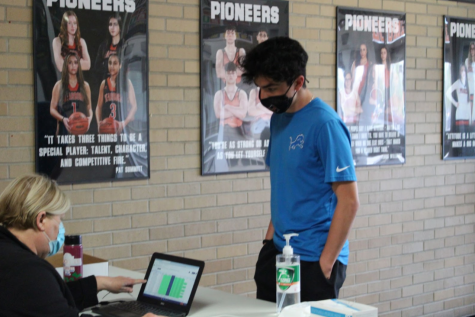DHS teachers share personal experiences with providing online instruction

It’s been almost a year since the outbreak of the COVID pandemic and virtual education. In Dearborn, it was announced that March 1, 2021 would be the initial date set for students to return to school. Teachers in the district have been using the platforms Zoom and Schoology to navigate through the obstacles of providing 100% online instruction since Sept. 2020. The situation has been hard for the teachers and students at DHS especially with the lack of social interaction and face-to-face communication.
Freshman history teacher Stenn Jedele said he is looking forward to returning to in-person instruction. “In-class learning is definitely better. While I have been surprised by how many students are able to keep up, there is an unacceptably high proportion of my students that simply can’t do it,” Jedele said. “Some kids have inadequate technology, or their home situation doesn’t permit them to stay on top of their work, or they simply need a teacher there to motivate them. Whatever the reason, I’m not able to help kids as effectively when we’re working remotely.”
Algebra teacher Joshua Feight said there have been some positive aspects to online instruction. “One big thing I’ve learned is that the Zoom chat is actually really good for students who want to speak up, but feel embarrassed or feel like someone will make fun of them. Being able to send messages directly to the teacher helps them get their questions out, and that’s a benefit for everyone,” he said. “Another thing is that it is so much easier to accept late work and read through it all because it’s not just a stack of papers that may or may not be organized. Schoology organizes things well and it’s easy to stay organized once you have a system.”
Teacher of students with an autism spectrum disorder, Suzanne Ladach, said teaching online has been difficult given the fact that it adds more hurdles for her students to overcome on top of the ones students already face in a traditional learning environment.“This disability affects communication – people with autism can struggle to express themselves with words, understand what someone is saying to them, or not learn the social rules of our society,” Ladach said. “It is much harder – but not impossible – to help my students grow. Some of my students have a difficult time staying on task. When we are in person it is much easier to redirect them. There are 5 adults that work in our classroom. Not being together has made it more of a challenge to communicate with each other and time each other real-time support.”
Special education teacher Kellyn Szajnecki said over the course of time teaching virtually, she has learned to be empathetic and patient with her students and the unfortunate situation. “Through online teaching, I have learned a lot about patience and acceptance. Realizing quickly last March that I cannot control or cure our circumstances, I had to get in touch with accepting that things were not going to look and feel like they had previously,” Szajnecki said. “I also learned a lot more about how every student has a very different home environment, and that I must take these individual circumstances into consideration.”
Special education teacher Elizabeth Wrona said although personal interaction yields a robust bond, online is an ideal platform for the quieter students to express themselves. “Face to face, I feel like I develop a stronger connection with students. Online, some of the more shy and less confident students are better able to express themselves and contribute to class,” Wrona said. “We do a play during first semester senior Language Arts and the students read the roles in class. It’s a fun experience and one we, unfortunately, couldn’t duplicate online. We were able to get through the material, but it wasn’t the same.”
Freshman biology teacher Sara Jaber has been a teacher at DHS for the past three years. She said that teaching online has taught her to persevere when faced with new obstacles. “I didn’t pursue education to stare at a screen 24 hours a day. I can’t wait to return to normal. Unfortunately, we can’t until numbers get better and although some in the community take heed and mask up; others do not, and until we are on the same page about following health guidelines- we will continue to be in this position,” Jaber said. “I learned to keep my head up in the face of an unrelenting storm. And you know what? I came out stronger and tougher. I pushed through and cultivated a plethora of tech skills that I will certainly carry with me into the future.”
This change will happen gradually grade by grade, and by March 15, 2021, the rest of the students will be back in school. Although some students will physically be in school, precautions will be taken.








